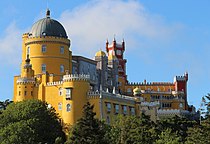Neo-Mudéjar is a type of Moorish Revival architecture practised in the Iberian Peninsula and to a far lesser extent in Ibero-America. This architectural movement emerged as a revival of Mudéjar style. It was an architectural trend of the late 19th and early 20th centuries that began in Madrid and Barcelona and quickly spread to other regions in Spain and Portugal. It used Mudéjar style elements such as the horseshoe arch, arabesque tiling, and abstract shaped brick ornamentations for the façades of modern buildings.
History

The first examples of Neo-Mudéjar buildings were the Aguirre School designed by Rodríguez Ayuso, the Plaza de Toros in Madrid built in 1874 (now demolished), and the Casa Vicens by Antoni Gaudí i Cornet. The style then became almost "compulsory" for the construction of bullfight rings all around Spain, Portugal and the Hispanoamerican countries. In Madrid it became one of its most representative styles of the period, not only for public buildings, like the Aguirre School or the bullring of Las Ventas, but also for housing. The use of cheap materials, mainly brick for exteriors, made it a popular style in new neighborhoods.
Neo-Mudéjar was often combined with Neo-Gothic by architects such as Francisco de Cubas, Antonio María Repullés y Vargas and Francisco Jareño. After the Ibero-American Exposition of 1929 in Seville, another stream of Neo-Mudéjar features appeared known as Andalusian Architectural Regionalism. The Plaza de España (Seville) or the ABC newspaper headquarters (Madrid) are examples of this new style that combined traditional Andalusian architecture with Mudéjar features.
List of notable Neo-Mudéjar buildings
| This list is incomplete; you can help by adding missing items. (August 2008) |
- Arenas de Barcelona
- Gran Teatro Falla, Cádiz
- Las Ventas bullring, Madrid
- Casa Vicens, Barcelona
- Monserrate Palace, Sintra
- Church of Santa Cruz, Madrid
- Palacete Conceição e Silva, Lisbon
- Church of La Paloma, Madrid
- Quinta do Relógio, Sintra
- Water tower (now exhibition space) Torre de Canal Isabel II, in Madrid.
- Escuelas Aguirre, Madrid
- Pena Palace, Sintra
- Toledo railway station
- Nazaré Bullring, Nazaré
- Zaragoza Post-Office
- Campo Pequeno bullring, Lisbon
- Morisco Kiosk, Mexico City
- Palacio de Orleans-Borbón (now city hall), Sanlúcar de Barrameda
- Palacio de Doña Trinidad Grund (now town hall), Carratraca
- Hotel Alfonso XIII, Seville
Gallery
-
 Palacio Laredo in Alcalá de Henares, 1884
Palacio Laredo in Alcalá de Henares, 1884
-
 Las Ventas bullring, Madrid, 1929
Las Ventas bullring, Madrid, 1929
-
 Mudéjar Pavilion, Museum of Arts and Traditions, Seville, 1914
Mudéjar Pavilion, Museum of Arts and Traditions, Seville, 1914
-
 Arc de Triomf, Barcelona, 1888
Arc de Triomf, Barcelona, 1888
-
 Campo Pequeno bullring in Lisbon (Portugal), 1892
Campo Pequeno bullring in Lisbon (Portugal), 1892
-
 The Toledo railway station, 1919
The Toledo railway station, 1919
-
 The Toledo railway station, 1919
The Toledo railway station, 1919
-
 Neo-Mudéjar building in Seville, 1909
Neo-Mudéjar building in Seville, 1909
-
 Church of Niño Jesús in Madrid, by Francisco Jareño, 1885
Church of Niño Jesús in Madrid, by Francisco Jareño, 1885
-
 Casa del Reloj, Arganzuela, Madrid, 1933
Casa del Reloj, Arganzuela, Madrid, 1933
-
Gran Teatro Falla of Cádiz, 1884
-
 Comillas Pontifical University building in Madrid
Comillas Pontifical University building in Madrid
-
 Clock Tower in Villarrubia de los Ojos, Ciudad Real, Spain.
Clock Tower in Villarrubia de los Ojos, Ciudad Real, Spain.
-
 Ermita de la Virgen del Val in Alcalá de Henares, 1926
Ermita de la Virgen del Val in Alcalá de Henares, 1926
See also
References
- ^ Editors of Time Out (13 December 2013). Time Out Madrid. Time Out. p. 21. ISBN 978-1-84670-297-6.
- Alejandro Lapunzina (1 January 2005). Architecture of Spain. Greenwood Publishing Group. p. 56. ISBN 978-0-313-31963-1.
- Jeremy Head (31 January 2011). Frommer's Seville, Granada and the Best of Andalusia. John Wiley & Sons. p. 1230. ISBN 978-1-119-99445-9.
- "Palacete Conceição e Silva (Avenida da Liberdade, n.º 226-228)". patrimonioislamico.ulusofona.pt. Retrieved 26 April 2021.
- ^ "Estilo Neoárabe". patrimonioislamico.ulusofona.pt. Retrieved 26 April 2021.
- AnneLise Sorensen; Geoff Garvey (30 March 2009). The Rough Guide to Spain. Penguin. p. 588. ISBN 978-1-84836-838-5.
- "Ayuntamiento (Palacio de Doña Trinidad Grund)". Diputación Provincial de Málaga. Retrieved 9 September 2023.
External links
- Cunill, Inmaculada Rodríguez. ARQUITECTURA DEL SIGLO XIX. ISBN 978-84-9714-052-2.
| Portuguese architecture | ||
|---|---|---|
| Styles |  | |
| Structures | ||
| Elements | ||
| Colonial | ||
| Others | ||
| Historicism and Revivalism in architecture and decorative arts | |
|---|---|
| International |
|
| France | |
| Germany, Austria-Hungary | |
| Great Britain | |
| Greece | |
| Italy | |
| Netherlands | |
| Nordic countries | |
| Portugal | |
| Poland | |
| Romania | |
| Russian Empire and USSR | |
| Serbia | |
| Spain | |
| United States | |
